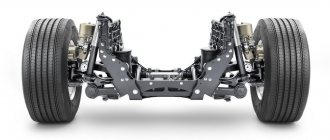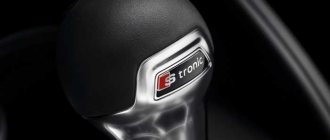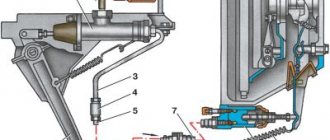Not all motorists know what AWD is and what its purpose is in a car. The situation is clarified by decoding the abbreviation AWD: translated from English “All whell drive” this means “all-wheel drive”. Many find it difficult to answer what the key features of this modern technology are. This is exactly what will be discussed in this material, which has not only purely informational, but also practical significance for many of our readers.
RWD - rear wheel drive
Rear-wheel drive is classic; the first cars were equipped with it back in the 30s. last century.
The engine is located at the front, torque is transmitted through the gearbox, driveshaft and axle to the rear axle of the wheels.
Today, RWD is found on older cars and some modern premium cars (BMW, Toyota), and is also installed on sports cars. Rear-wheel drive is especially appreciated by drifting enthusiasts.
The advantages of rear-wheel drive are that cars with it have excellent acceleration dynamics, because when the driver presses the gas, the weight of the car is transferred to the rear axle.
Due to the fact that on a rear-wheel drive car, the front pair of wheels only sets the turning trajectory, its radius decreases, which allows the driver to successfully “fit” into the bends of the road even at high speed. The body of rear-wheel drive cars does not vibrate at all from engine operation, which increases passenger comfort.
The disadvantages of the RWD drive are the high cost of its implementation, as well as design features: due to the presence of a cardan shaft, through which torque is transmitted to the wheels, special tunnels are used, as a result, the useful area inside the cabin and trunk is reduced.
Also, the disadvantages of rear-wheel drive cars include handling: on a snowy, slippery road, a car with RWD easily skids, so rear-wheel drive is recommended for more experienced drivers. At the same time, it is easier to cope with a skid or prevent it in a rear-wheel drive car - just slightly turn the steering wheel in the opposite direction.
AWD or monowheel drive
AWD is a new type of layout (mono-wheel drive), which has gradually conquered the automotive market. It is used on many modern sedans, SUVs, crossovers: Audi S4, Renault Duster, Subaru Forester, Hyundai Greta. Models with such a system drive in a standard situation on one drive, but when there is not enough traction, the second axle is automatically connected.
Although vehicles with All Whell Drive are considered off-road, they are not actually off-road. All four wheels here do not rotate constantly, but from time to time. The usual percentage of effort on the axles is 60/40 in favor of the front. For Subaru, Audi and the like, the distribution is carried out in a 50/50 ratio.
There are two types of AWD:
- constant (the drive is automatically supplied to both axles, which provides an advantage on ice, snow and mud);
- connectable (rotation is sent to only one axle, depending on the model it can be the front or rear axle).
FWD - front wheel drive
Front-wheel drive is installed on the vast majority of modern cars.
The engine and gearbox are located at the front, often transversely. The torque from the engine is transmitted through the CV joint to the wheels of the front axle.
The engine in vehicles with FWD can be mounted longitudinally or transversely mounted in front of, behind, or above the front axle.
There are three types of engine layout for front-wheel drive cars:
- sequential, when the engine, main gear and gearbox are placed one behind the other on the same axis;
- parallel, when the engine and transmission are located on two parallel axes at the same height;
- floor, when the engine is located above the transmission.
In any case, the main distinguishing feature of a front-wheel drive device is that the engine, gearbox, drive and differential are combined into a single unit for transmitting torque to the front axle.
This is both an advantage and a disadvantage of FWD : this solution is more profitable to manufacture, and the absence of a driveshaft allows for maximum use of interior space and reduces the overall weight of the vehicle. At the same time, the design of the unit itself becomes more complex, and the complexity of repairs increases.
Plus handling nuances - yes, a rear-wheel drive car is easier to skid, but it’s also easier to get out of it using RWD.
The advantages of front-wheel drive cars include ease of handling and good cross-country ability - by adding more gas, in a car with FWD you can get out of the snow porridge and go uphill, because the weight of the front part of the car does not shift back and the front wheels row, dragging the car along.
In winter, because the weight of the engine loads the driven front axle, better traction is created. Therefore, front-wheel drive cars are recommended for beginners.
Front-wheel drive cars are also advantageous. Firstly, their mass production and design are cheaper for the manufacturer and, therefore, for the buyer than other types of drives. Secondly, due to the short transmission, the engine loses less power than in the case of rear- or all-wheel drive, which translates into lower fuel consumption. And cars with FWD are cheaper to maintain.
The disadvantages of front-wheel drive cars include low acoustic comfort - the driver will always feel vibrations from the engine that are transmitted to the body.
Due to the fact that the constant velocity joint is completely combined with the steering, on FWD cars the turning radius will be higher than in the case of a rear-wheel drive car - and this must be taken into account by braking in advance before entering the turn. The hinges themselves are expensive, and if they fail, the owner is faced with expensive repairs.
Due to the fact that the front wheels on FWD cars are overloaded (they transmit torque, control the vehicle's movement, and dampen road irregularities), and the center of gravity is shifted to the front axle, the maneuverability of front-wheel drive cars and acceleration dynamics leave much to be desired. When accelerating hard in a front-wheel drive vehicle, the front wheels may slip.
If the engine is located transversely on a front-wheel drive car, CV joints of different lengths are placed on the wheels, which leads to the fact that when accelerating the car begins to pull to the right or left - and the owner is forced to use “power steering,” which also does not add driving comfort.
Story
All-wheel drive systems on cars were not invented yesterday. Their origins go back as far as the century before last.
In 1893, the English engineer-inventor Bramah Joseph Diplock designed and applied an all-wheel drive system for a tractor-tractor. This design, even by modern standards, aroused respect among many, in those years was the height of engineering art. The all-terrain tractor conquered off-road terrain easily using three differentials and an all-wheel drive system with four (!) steered wheels.
Technology for Beginners: What's the Difference Between All-Wheel Drive, Rear-Wheel Drive and Front-Wheel Drive
The first all-wheel drive car with an internal combustion engine was the Spyker 60 HP, created by the brothers Jacobus and Hendrik-Jan Spyker from Holland, which was a two-seater sports car used for racing up mountains (for hill climbing). This important event in the development of these all-wheel drive systems occurred in 1903.
Then there was a German unsightly-looking car of the Dernburg-Wagen model built. It was already followed by a whole galaxy of different prototype machines and the search for a reliable, unpretentious and optimal design.
In the pre-war years before World War II, in collaboration with BMW, she developed the military series of G vehicles. These efforts were rewarded with the creation of unusual and unique cars. But the real well-deserved fame was given to a completely different legendary car of the war years, which came from another continent and walked side by side along the military paths with our grandfathers along the impassable bombed roads of the Bryansk region, the Moscow region, Belarus, Poland and finally Germany itself, this car is the Jeep Willys.
The all-wheel drive control system in the car was simple and effective. One press of the lever on the jeep turned on the drive to all four wheels at once, and with another selector (lever) it was possible to select high gears, neutral or low gears on the car.
30 years of all-wheel drive BMWs: from mechanical to hybrid AWD systems
The all-wheel drive system evolved throughout the 1950s and 1960s. Then external locking of the front hubs appeared, which made it possible to disable the front axle to improve fuel efficiency and speed performance. In 1963, the Jeep Wagoneer, a family four-wheel drive vehicle, received an automatic transmission. Ten years later, the Quadra-Trac system was installed on the updated car model, i.e. The industry's first automatic full-time four-wheel drive system.
All-wheel drive is gradually moving to passenger cars. Around the same time, namely, when American engineers were developing “heavy artillery,” the Japanese tried to graft this all-wheel drive system onto their passenger cars. The first symbiosis of an off-road drive and a passenger body was embodied by the Japanese in the Subaru Leone. The model appeared in 1972. Its distinctive features were the system itself with the so-called plug-in all-wheel drive, which helped car owners well in bad weather or road conditions.
In 1980, AMC released the Eagle car model, which set the standard among all-wheel drive passenger cars of those years. The model was equipped with permanent automatic all-wheel drive. At the same time, a real legend is born, i.e. The first-born Audi Quattro with permanent all-wheel drive, which was used for the first time not to improve off-road performance, but to improve grip, handling and performance in motorsport.
1983 Jeep has a new Select-Trac system. From then on, these Jeeps could drive in their all-wheel drive version at high speed on ordinary roads without damaging the transfer case. The following year, the new Jeep Cherokee introduced a more advanced all-wheel drive system - Command-Trac, which made it possible to connect the front axle directly on the go (while driving).
Beginning in the mid-90s, almost every automaker in the United States began creating SUV (sports utility vehicle) models. They were made simply, that is, they took the frame base of a pickup truck and the mechanical 4WD drive itself. Technically, the insides of the car remained archaic (the same), but they worked in a new fashionable body.
The sensational popularity of SUVs has forced many automakers to follow the lead of marketers and consumers. Car bodies began to be made load-bearing, and the frame structure was gradually abandoned. A class of crossovers was born, which quickly developed and conquered more and more new market segments. In their environment, AWD systems* are quickly beginning to prevail.
This is interesting: A short guide to Mercedes-Benz 4Matic all-wheel drive systems
*All-wheel drive (AWD), capable of transmitting power between both axles, as well as from wheel to wheel. A much more convenient automated all-wheel drive system offers almost all the same benefits as a classic 4WD system, but with fewer inconveniences for everyday use. However, you have to pay for these conveniences with less drive reliability.
4WD - all-wheel drive (permanent and plug-in)
There are two types of all-wheel drive - permanent (Full-Time) and connected (Part-Time).
- In the first option, torque is permanently transmitted to the rear and front axles, usually in a 50/50 ratio.
- In the second, one axis is enabled by default, but another is also connected if necessary.
There is also “all-wheel drive on demand”, which is activated by a button in the cabin or by a control electronics solution. But it already belongs to the AWD .
The plug-in all-wheel drive (Part-Time) is designed quite simply: the front axle is rigidly connected, the rear axle is connected via a simple mechanical clutch - and no differentials.
Due to such a rigid engagement, the distribution of torque along the axes is the same.
Real SUVs (UAZ, Toyota Land Cruiser 70, Nissan Patrol, Suzuki Jimny), pickup trucks (Ford Ranger, Nissan Navara) and military equipment are equipped with this type of all-wheel drive.
Such cars have fantastic cross-country ability, but on asphalt they are rear-wheel drive vehicles that require special treatment. In particular, this type of all-wheel drive on paved roads results in reduced handling. High load on the transmission quickly damages it. Tires also wear out quite quickly.
Permanent all-wheel drive (Full-Time) is perhaps the most technically complex and expensive type of drive in modern cars.
This design contains both a center differential and cross-axle differentials for optimal distribution of transmitted power to each wheel. And the center differential is also accompanied by a locking mechanism, which increases the vehicle's cross-country ability.
The permanent all-wheel drive segment includes premium SUVs such as the Mercedes Gelendewagen. Also, 4WD drive with center differential lock is used as an expensive option on premium cars, which increases the stability of the car and gives it excellent dynamic characteristics.
Moreover, so that permanent all-wheel drive does not require other control techniques, manufacturers strive to give such cars the character of rear-wheel drive , unevenly (for example, 30/70, as in Mercedes-Benz in the 4Motion version) distributing the load between the axles. Or they provide for the distribution of torque not only between the front and rear axles, but also between the wheels, which allows for excellent handling, especially in turns, when up to 70% of the torque is transferred, for example, to the outer rear wheel. An example implementation is the Honda SH-AWD drive system.
As you can see, the main advantage of all-wheel drive vehicles is their cross-country ability, fast dynamics, no wheel slipping, and low risk of skidding.
The optimal distribution of torque across the axles and wheels gives the car excellent directional stability, especially when cornering.
The disadvantages of permanent all-wheel drive include the complexity of the design, the abundance of additional devices and control electronics - all this affects both the cost of the car and the cost of its operation and repair.
Fuel consumption on all-wheel drive vehicles is significantly higher due to the loss of power in transmitting torque to two axles at once.
In general, all-wheel drive today serves as more of an expensive option on premium cars.
It remains truly necessary only on brutal frame SUVs - but that’s a completely different story.
What are the disadvantages of the AWD drive system?
An important difference between the drive system under consideration and the 4WD system is also the absence of lower gears, and there is no practical possibility of locking differentials. This is not very convenient when driving off-road, causing fair criticism from many car professionals, since with the help of a lower gear it would be possible to significantly increase power, and blocking the differentials would prevent wheel slipping.
https://www.youtube.com/watch?v=c8k4oISga78
Therefore, another important piece of advice: if you have purchased a car equipped with an AWD system, always remember that the main role on the trip may well be played not by your driving skills, but by the quality of the program of the computer installed on board the car. That is why the choice of car must be thought out to the smallest detail. Good luck!
AWD - automatically connected all-wheel drive
All-Wheel Drive is the modern stage in the evolution of plug-in all-wheel drive.
As in the case of the Part-Time drive, the second axis is connected here on demand, but here to fulfill the requirement it is enough to activate the corresponding mode by pressing the button in the cabin. Another option is when the second axle is connected automatically when the wheels of the leading axle slip.
As a rule, the main driving axle is the front one, and if necessary, all-wheel drive is connected, and the torque begins to be transferred to the rear axle in a ratio of basically 60/40 to the front/rear axle.
This is realized by means of an interaxle coupling. There is no differential, and due to the fact that a hydraulic or electromagnetic clutch allows the axles to slip, the vehicle's handling in all-wheel drive mode is improved.
This leads to a drawback of the AWD drive - overheating of the clutch due to constant high friction. In this case, the clutch either stops supplying torque or fails altogether. Because of this, serious off-road conditions are contraindicated for such vehicles.
A special feature of cars with AWD is “fool proofing”. That is, the owner can block the clutch before a difficult section of the road so that the all-wheel drive remains engaged, but if the electronics determines the speed to be higher than safe for a given driving mode, the clutch can unblock itself.
AWD is found everywhere on crossovers such as Renault Duster, Nissan Terrano, Mitsubishi Outlander, Toyota RAV4, Kia Sportage, etc. The popularity of this type of drive is only growing.
The advantages of the AWD drive are that it is more economical in terms of fuel consumption than full-fledged all-wheel drive, while significantly helping the driver in difficult situations - steep climbs, sharp acceleration and poor road surfaces.
Disadvantages of AWD : complex design, extra weight, high cost of maintenance and repair. Compared to classic all-wheel drive, All-Wheel Drive is less durable and reliable.
What kind of car drive systems exist?
First, it’s worth figuring out what the main difference between this technology and other similar technologies associated with car drive systems is. In particular, what is the difference between AWD and 4WD technology is also a very common question. Finally, what are the advantages that make drivers adopt it?
Considering the essence of technical innovation, AWD is, by and large, an automatic system that operates independently of the drivers. And this is one of its main specific features. To understand this, you need to understand exactly how it works.










